 | |||
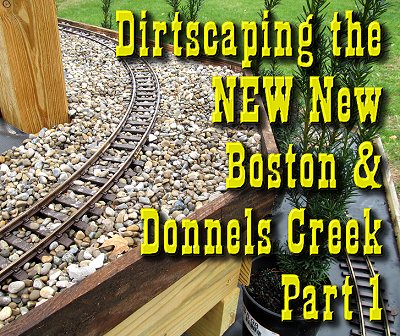 |
 |
 | |
 |
 | ||
 |
 | ||
 |  | ||
 |  | ||
 | |||
 |
 |
 | |
 |
 | ||
 |
 | ||
 |  | ||
 |  | ||
| Written by Paul D. Race for Family Garden Trains(tm)
and New Boston and Donnels Creek: |
 |
|
|
Dirtscaping the NEW New Boston and Donnels Creek RR, Part 1If you've been following along with our planning, groundbreaking, and framing articles, you know that we are building a new garden railroad that will be built as solid and entirely raised for low maintenance (and less stress on my knees and back than my former railroad). By the time I'm finished, my "garden" railroad will essentially be a series of large, raised planters. Since I haven't seen this approach actively promoted by anyone else, I may be "boldly going where no garden railroad has gone before." Except for the professionals; some of them do this all the time, then they do things that camouflage the basic structure. I'll do that, eventually, but not this year - time is running out.This is article is a follow-up to our "Decking the NEW New Boston and Donnels Creek RR" article, in which I decked the middle layer with 2"x6" ground-rated boards (which weren't that much more expensive than any of the other solutions, but which were much more likely to last a very long time). By now, I had also decked out the top layer, installed a vinyl underlayment over the decking, and installed a loop of track based on R2 curves. So, technically, the top layer has been almost ready for "dirtscaping" for some time. Where Things StoodAt the end of the last article, I had finished decking what will eventually be the "middle layer" of my proposed 3-layer railroad. The next steps before the track and the dirt and the plants are installed would be installing the vinyl on the middle layer and attaching something to keep the gravel and dirt from coming off the edges. I also had the track painted and assembled into subsections so it was almost ready to install. Vinyl UnderlaymentHaving bought a new box of staples for my staple-gun, I rolled out my billboard vinyl again and started cutting and patching. It took a bit more than I expected it to, but I had bought a slightly larger piece than I had, technically, needed, so that wasn't a problem. Also, if I was using this for a pond or roofing or something that had to be waterproof, I wouldn't have patched so gleefully. But I was going to be poking drainage holes in this anyway, so having more patches and staples than Frankenstein's monster wouldn't really hurt anything.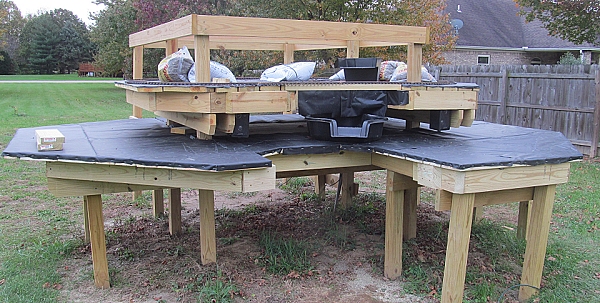 In the photo above, you can see the bags of dirt and gravel I bought several weeks ago, as well as the two pond fixtures I was hoping to install this year. Weather permitting, I still may get them in place, but it's a little late to start a working waterfall. So getting it running may be a spring project. Especially if it stays as cool as it was the last two days (high about 42F). Quest for a Shrubbery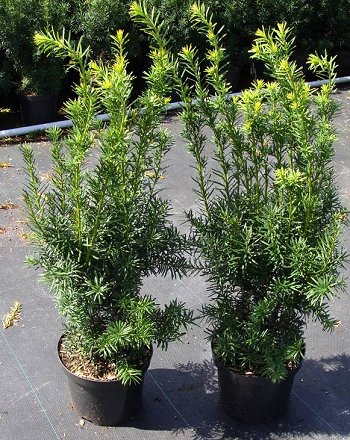 I had hoped to pick up some evergreens at the year-end closeout sales at the neighborhood stores, but a bunch of landscapers had apparently beat me to the punch. There were no Dwarf Alberta Spruce, no Hetz Midget Arborvita, no Boulevard Cypress, no Mugo Pine - none of the varieties I had enjoyed on my other railroad. I had hoped to pick up some evergreens at the year-end closeout sales at the neighborhood stores, but a bunch of landscapers had apparently beat me to the punch. There were no Dwarf Alberta Spruce, no Hetz Midget Arborvita, no Boulevard Cypress, no Mugo Pine - none of the varieties I had enjoyed on my other railroad.
At a Home Depot, I found some nice Holly ("Royal Duet") to plant on one side of the house. And I caught site of a goofy-looking Taxus I had never seen before which is purported to have a much more upright growth habit than the common varieties - Taxus Hicksii. It was 80% off, so it was worth a couple dollars each to bring them home. I have had plenty of experience with "standard" Taxus varieties and knew Taxus is not railroad-friendly. But when I put those two goofy Hicksii Taxus on my platform, it made me want more stuff. So I got a few more. No, they won't be permanent residents on my railroad, but they were cheap and green. One potential experiment I'm considering is installing small potted evergreens on the railroad in the pot, then pulling them up after a year, putting them elsewhere, and getting some more. Some folks who only keep a few Dwarf Alberta Spruce on their property prefer replacing them every year or two to trimming them every year. Not saying I'll do a lot of this, but it's a possibility. These goofy shrubs won't stay on my railroad indefinitely anyway, so maybe it's worth trying this approach out with them. EdgingMy plan for the two layers I have built so far included putting pea gravel around the track on the outside. (Yes, crushed granite would look better, but it costs a LOT more.) Then I plan to put rocks and dirt toward the inside, with rocks somewhat separating the dirt from the gravel. What I needed before I poured the gravel, though, would be something to keep the gravel from spilling off the edges, plus dressing up the edges where the vinyl was tacked down.I tried several options that were very clever, but didn't work at all, so I won't bother telling you about them. I had held off on using lumber because I knew I'd have to cut a lot of little pieces to go around all those notches I put in place for the waterfall. When I realized wood was my only good option for now, I started looking for ground-rated 1"x2" or 1"x3" boards. I couldn't find any closer than two hours away. I toyed with the idea of ripping a ground-rated 2"x6" both ways, to get boards that were essentially 3/4" x 2 3/4". But that seemed like a boatload of work. What I did have was a handful of old 5/8"x5.5"x6' dog-eared fencing boards from a project I had never finished at the old house. They had been stored outside, so they had some nice weathering, and they were pressure treated, so I figured I'd give them a try. Also, they were only 5/8" deep, so they'd be less "intrusive" used this way. I ripped each board into two 2 3/4" strips, then took the boards, my circular saw, my drill, and a box of screws out to the railroad. A few stops and starts later, I had the edging up. The first photo shows a few from the east (the side facing the house). 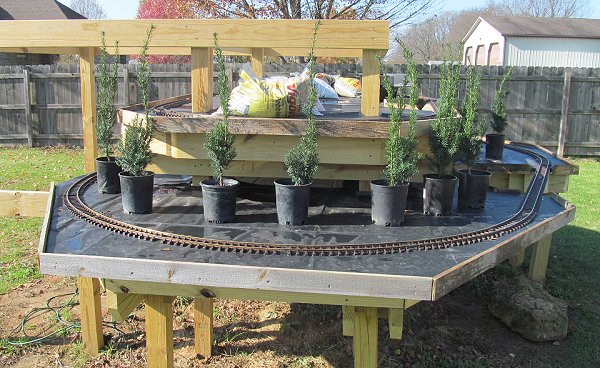 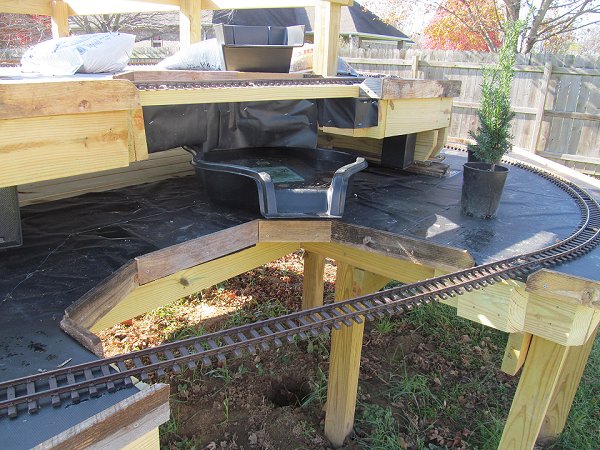 You may be able to see how I used the "dog-eared" ends of the board to make little notches where the track would pass the boards. Hopefully it will help keep things like steps from snagging. If not, I can always notch them a little more. Once I got started cutting and attaching the boards, it wasn't too bad. The most time-consuming part of this was probably adjusting my circular saw between 90 degrees and 45 degrees every two or three boards. Obviously if I had brought my table saw or some such to the back yard, that wouldn't have been a problem. But it also would have disguised the fact that a guy with a $35 circular saw can get "close enough" for such projects.
From almost the start, my plan was to dump gravel around the outside edges of each layer, where the track would go. In past lives, I used a product called Grani-Grit Turkey Grit, which was a crushed granite product that looked very nice. Unfortunately, it has become harder and harder to find in the larger grain sizes I wanted. Plus it costs a lot more than it used to when I can find it. You would be surprised how many "farm supply" stores in my area have no idea there is such a thing as turkey grit.
|



|

Note: Family Garden Trains?, Garden Train Store?, Big Christmas Trains?, BIG Indoor Trains?, and BIG Train Store? are trademarks of
Breakthrough Communications (www.btcomm.com). All information, data, text, and illustrations on this web site are
Copyright (c) 1999, 2000, 2001, 2002, 2003, 2004, 2005, 2006, 2007, 2008, 2009, 2010, 2011, 2012, 2013, 2014, 2015, 2016, 2017 by
Paul D. Race. Reuse or republication without prior written permission is specifically
forbidden.
Family Garden Trains is a participant in the Amazon Services LLC Associates Program,
an affiliate advertising program designed to provide a means for sites to earn advertising
fees by advertising and linking to amazon.com.
For more information, please contact us
 |  |
| Visit related pages and affiliated sites: | |||||
| - Trains and Hobbies - | |||||
 |  |
 |
 |
 |  |
 |

|

|  |
 |

|
| - Christmas Memories and Collectibles - | |||||
 |

|
 |

|
 |

|
| - Family Activities and Crafts - | |||||
 |

|

|

|

|

|
| - Music - | |||||

|
 |
 |

|

|

|

|

|

|

|

|

|

|

|

|

|

|

|